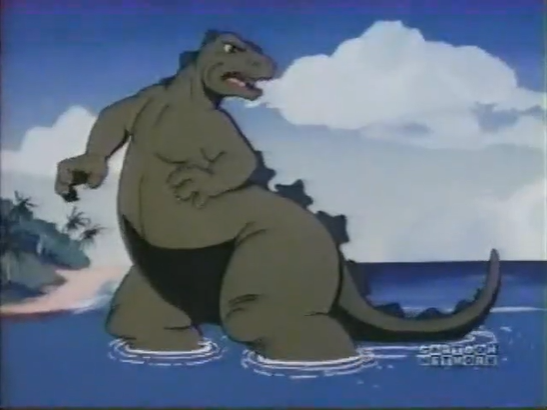
Since we are now on the cusp of seeing what happens when a Hollywood movie studio spends way too much money to remake King Kong vs. Godzilla, you’ll be seeing more kaiju content on this site over the next month or two, gathered under the “Daikaiju vs. 2021” tag. This is only the beginning.
What, did you think I was only going to write about good cartoons now? How dare you. I have an image to maintain.
G-Fans like myself have had the infamy of the Hanna-Barbera interpretation of our favourite radioactive reptile hammered into their psyches for decades—this is one of those classic terrible cartoons that was talked up endlessly in the pages, both paper and web, of snarky nerds, much in the same way as the Star Wars Holiday Special. One could only expect quality this low from H-B in the late seventies, one of the true nadir periods in animation, but the pure vitriol aimed at this show in particular (aired under many monikers, including The Godzilla Power Hour, which was also the name of my Christian ministry program until Toho sued it into oblivion), placed it near the bottom of an era that was already rife with barrel-scrapers. In that sense, it almost feels a bit difficult to write about in this day and age, because every mean thing that could be said about Hanna-Barbera’s Godzilla— all the details it gets wrong about the King of the Monsters and all the dumb things they add (including one thing in particular)—has probably been said years ago, maybe even in a monologue in a Kevin Smith movie. Yet, after finally watching it for the first time after hearing about the horrors of Godzooky for so long, I feel confident that there is enough material here to mine—not just about the insults it heaps on a venerable franchise, but also how it represents just what was so tepid about television cartoons of its time, Hanna-Barbera’s especially.
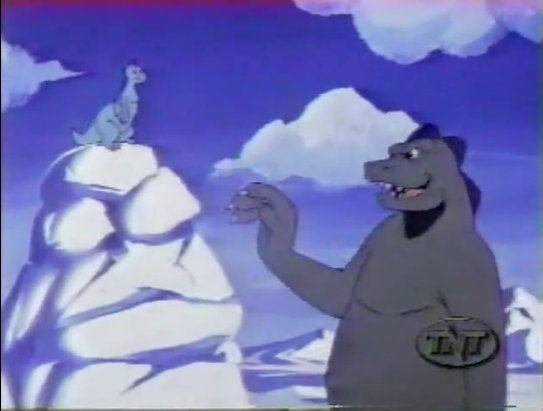
Let’s get the basic cruelties out of the way first: as many have pointed out, the show’s theme song and intro set expectations low right from the get-go, starting with a thunderous tune about Godzilla himself before quickly deflating itself by introducing us to the antics of Godzooky. Who is Godzooky, and why has his name become blasphemous among Godzilla fans? To put it plainly, Godzooky is more or less the dry run for Scrappy-Doo, who would be introduced a year after this show’s debut: an annoying “cute” “comic” “relief” character (the only time you get relief is when he’s not on screen, which is not often enough) who would constantly, annoyingly, get in the way of the plot. While there seems to be clear inspiration taken from Minilla/Minya from the Showa Godzilla movies, including his ability to spit smoke rings (and given how little care is given to the rest of the adaptation, the fact that they referenced something like that at all is surprising), Godzooky is his own, completely unwanted character, the kind that contributes almost nothing, but who they constantly cut to for reactions. In the way he was thought of by fandom, Godzooky was Jar Jar Binks before Jar Jar Binks.
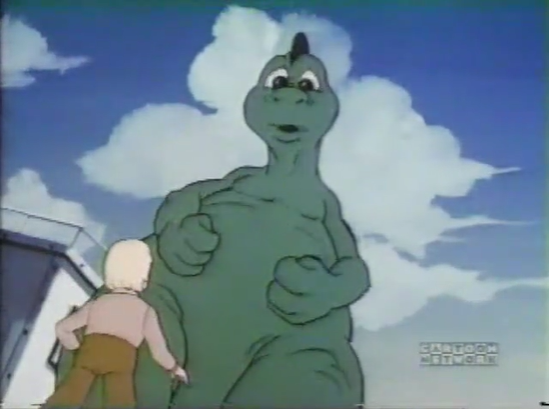
Most of Hanna-Barbera’s cartoons of that time had a character like Godzooky, but his presence in this show was especially unwelcome because he was taking precious screen time away from Godzilla, who the kids tuning in for a Godzilla cartoon actually wanted to see. It doesn’t help that, as a design, Godzooky is kind of ugly, usually drawn as wrinkly and awkward; Don Messick using a sub-verbal variation of his Scooby-Doo voice for him only makes it worse. Godzooky existence reminds us that there was a time when they’d put cute comic relief characters in every cartoon, but had no idea how to make something cute (hint: don’t have it be obviously voiced by a middle-aged man) or funny.
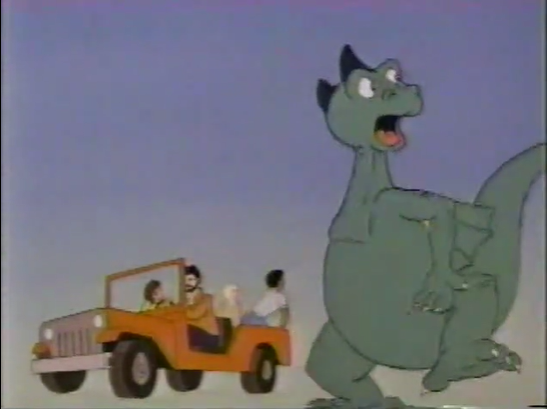
So, Godzooky is the main handicap this show has been saddled with, but his obnoxious-scene-stealing nature only really hides what else is wrong with it, which is pretty much everything. The premise has a crew of boring science nobodies (as well as the kid character required by seventies cartoon law, who says most of his lines at maximum volume, possibly making him the only character I wanted to see/hear from less than Godzooky) sailing around the world, reusing humorous run cycles where they constantly look away from the camera (so they didn’t haven’t animate their faces?), and chancing on a different monster each week, to which the inevitable response is to summon Godzilla from the depths. Yes, Godzilla looks like a less distinctive dinosaur in this (and don’t even try to figure out his actual scale), and yes, his atomic ray has been replaced with both fire breath and inexplicable eye lasers (which in one episode I watched he used to repair cracks in a dam somehow), and yes, his iconic roar is absent (replaced by more standard monster sounds from Lurch himself, Ted Cassidy), but the real problematic change made to the G-Man in this interpretation is just how domesticated he is, even compared to the more kid-oriented movies. In the first five minutes of almost every episode, some relatively minor problem for the humans—some big tidal waves, for example—lead to them to call Godzilla so he can deal with it (the ship’s captain has a special button he can press to call him, but Godzooky can also do it on his own—why do they need both methods?) It’s one thing for him to fight off evil monsters to help people, it’s quite another for him to be at their beck and call to get them out of every fairly mundane nautical jam they get themselves into. Eventually, the monster of the week shows up, and since our crew is always near a body of water (even if it’s a river that couldn’t possibly be deep enough for Godzilla—but why question it if the writers clearly didn’t?), they call up Godzilla again. Once portrayed as a powerful force of nature, Godzilla has been turned into our human characters’ butler, and he suffers that indignity without complaint—the darkness and moral ambiguity had already been bled from the character long before that, but there’s still something very wrong about hearing a crowd a humans shout out “It’s Godzilla! He’ll save us!”
(I feel like Hanna-Barbera made more than a few cartoons in that period that involve the audience waiting for the inevitable moment when the mortal protagonists summon an essentially invincible being to solve their problems immediately, including Shazzan and their version of Marvel Comics’ Thing. It’s certainly a plot structure that removes all tension and makes every episode feel even more formulaic.)
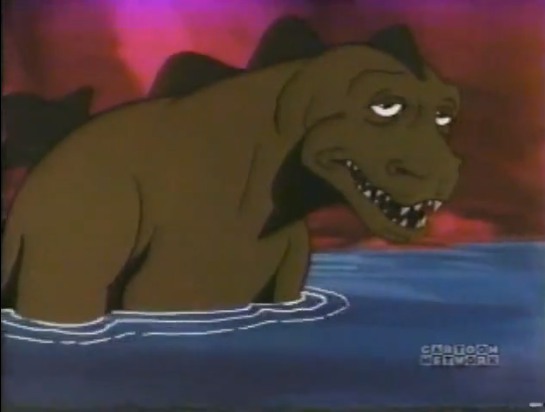
Even as just a monster fight delivery system, this show is severely flawed. Part of the problem is that the monsters simply aren’t very interesting, having generally pretty limp designs and humdrum gimmicks (this one lives underground and eats rocks, causing buildings to collapse! This one eats energy and can transform into other things, which helps it somehow!), and chances are most of them were just reused from another one of the dozens of cartoons H-B were putting out at that time (while they did have good artists working for them, you can really feel the absence of someone like Alex Toth, whose monster designs for older H-B cartoons like Herculoids are infinitely cooler and more likeable.) There’s also the spectre of the violence-averse nature of seventies cartoons, with the “fights” mostly consisting of some grappling and clashing energy beams before Godzilla disposes of his enemies in the most unspectacular fashion they can get away with, such as dodging out of the way to let a monster fall off a cliff, or trapping them in an underwater cave (considering that particular monster wasn’t aquatic, was he just leaving it to drown?) Take all that with the totally expected stiffness, inconsistency, and repetition of Hanna-Barbera animation—I sure hope you like watching Godzilla roar at nothing, or flail his disturbingly human-proportioned arms in the air—and the equally poor writing (showing so little confidence in its audience that they feel the need to have the kid yell “Godzilla is using his eye beams!” while Godzilla is currently on screen using his eye beams), and you have a recipe for disaster, but not the good kind of disaster that you want from Godzilla.
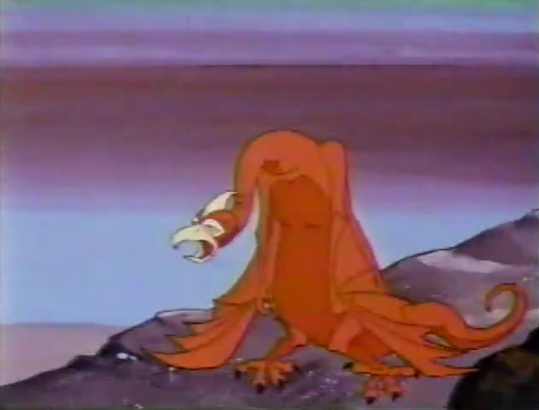
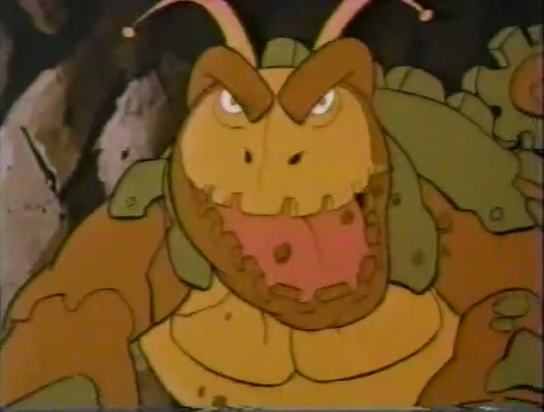
Aside from my innate curiosity/masochism when it comes to old cartoons, there were only a few things that buoyed my spirits as I slogged through a sampling of episodes (especially when I got to the ones where there wasn’t even a monster fight, such as when the younger members of the crew were trapped in a whale-shaped, seafloor-pillaging submarine, a story that was both incoherent AND boring): spotting weird/awkward bits of animation, the odd bit of actually pretty good animation that must have ended up in there by mistake, and getting to see intentionally goofy bumpers from Cartoon Network and TNT, where reruns aired well into the nineties. If my writing an entire post about shows like TNT’s MonsterVision has shown anything, it’s that I’ve come to really appreciate the fun of those nineties Ted Turner channel flourishes.
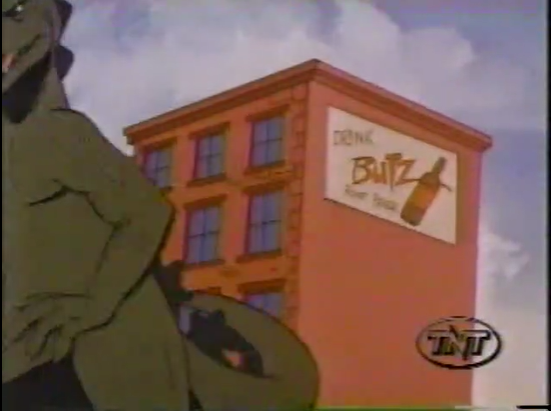
What I’ve really come away with after finally watching these Godzilla cartoons is not how it diminishes its source material (lord knows Toho has been capable of doing that on its own), but how, just like in Hanna-Barbera’s other offerings from the seventies and into the eighties (like, say, Pac-Man), all they really do is remake the same show over and over again and change the characters slightly. I feel like that’s been the recurring theme throughout my writings on bad cartoons: that this assembly line approach to TV animation was what kept the whole industry down for so long. The difference here is that, unlike some of the awkward attempts to transmute a property into Saturday morning doldrums, Godzilla is something already kid-friendly and exciting—so the story then becomes how they found ways to remove everything exciting about it, setting the tone for bad animated adaptations for decades to come.
(Also, if you’d like more comedy at this show’s expense, with significantly better-quality screencaps, go here.)
BUT, IS THE THEME SONG CATCHY? The early parts of it have a sort of goofy grandeur to them…until Godzooky comes in and ruins everything, as always.